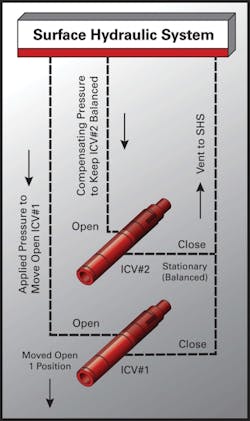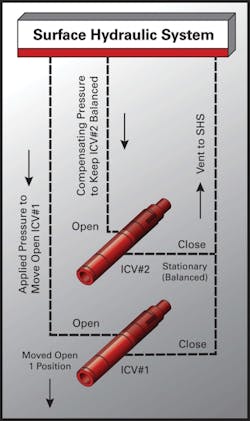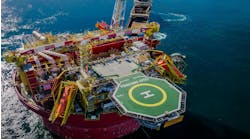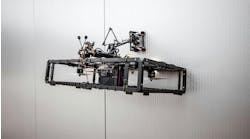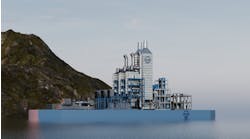Anand Venugopal
Savio Saldanha
Halliburton WellDynamics
An intelligent well optimizes well, production, and reservoir management processes by enabling the operator to remotely monitor and control well inflow or injection downhole at the reservoir, without mechanical intervention.
Since its first SmartWell installation in 1997, Halliburton has deployed 519 such installations covering 1,238 zones. These installed systems employ a variety of control system types, including electro-hydraulic, all-hydraulic digital, and direct hydraulics. Building on this track record and incorporating reliability improvements made over the last 15 years, Halliburton has introduced new concepts in downhole control systems technology for intelligent completions. This article focuses on surface positioning, a surface control system architecture that uses a combination of proprietary surface-based algorithms and surface hydraulic units to remotely control downhole interval control valves (ICVs) without the need for additional downhole flow control devices.
Market drivers
Intelligent completion systems improve reservoir utilization and recovery efficiencies by providing the operator with the ability to remotely position ICVs in discrete choking positions to satisfy specific production or injection philosophies. Traditionally, this advanced reservoir management functionality has been achieved through the use of a dedicated downhole flow control module, which when integrated with the ICV provides the operator the ability to incrementally position the ICV choke trim.
With the increasing acceptance of intelligent completion technology in today’s challenging environments, more clients look to this technology not only for their prolific or high-end assets but also for applications involving mature or marginal fields. Operators have expressed interest in the development of alternative control systems/concepts that address the economics of implementing this technology in marginal assets.
Surface positioning uses a combination of proprietary surface-based algorithms and surface hydraulic units to remotely control downhole interval control valves (ICVs) without the need for additional downhole flow control devices.
One such concept is to leverage the functionality of automated surface control system units to discretely position downhole ICVs without the need for additional downhole flow control hardware. This control strategy is seen to be of particular benefit for use in marginal and non-premium markets, where operators subscribe to moderate choking requirements with a focus on minimizing capital and operating expenses incurred with deploying and maintaining additional downhole tools.
Halliburton’s Accu-Pulse downhole control module, when paired with an ICV, incrementally moves an ICV choke trim by metering the volume vented from the hydraulic chamber of the ICV. This metered volume translates to a linear movement of the valve. This system draws its reliability from being able to repeatedly position the choke trim with high accuracy (+/- 0.010 in.) over the entire stroke length. The Surface Positioning control system attempts to emulate this concept without using additional downhole flow control modules.
The mechanical actuation of the ICV is based on the application of hydraulic pressure through dedicated control lines that run from the surface down to the tool. As such, one of the challenges to implementing this concept arises in multi-zone wells, where incremental positioning of one ICV needs to be done without simultaneously affecting other ICVs in the completion string. Changes in wellbore parameters such as depth, deviation, temperature, control line fluid properties, and valve seal friction can affect the reliability of the system and also compound the challenge of developing standardized solutions that can be applied across multiple well profiles in various applications.
Design
With these challenges in mind, the Surface Positioning control system solution was developed using Halliburton’s Surface Hydraulic System (SHS) as a framework to incrementally control the ICV position in each zone. Using this method, a specific pressure is applied for a specific time interval to one side of the ICV piston to cause it to move the desired increment. This exposes or closes a specific number of flow ports on the choke trim. A specific volume of fluid, corresponding to the stroke of the valve is now displaced from the return side of the piston. A correlation is then derived between the return fluid displaced and the linear stroke of the ICV piston.
Estimates of time delays associated with pressure transients and the corresponding line pressure responses are modeled using simulation software. The calibration parameters and the simulation results are then collated as inputs to a programmable logic controller that is part of the SHS. If the valves are configured in the common line architecture, compensating pressure is applied to other ICVs to maintain their current position and to prevent inadvertent valve movement. Once the valves have been calibrated corresponding to the well conditions, repeated actuations can be performed reliably using the estimated calibration parameters.
Benefits of this technology include the elimination of additional downhole mechanical hardware, which has a direct result on increasing the overall functional system reliability. This also translates to reduced capital expenditure along with significant reduction in manufacturing and equipment delivery lead times. Moreover, in the event of failure on any surface hydraulic system components, the parts can easily be replaced without costly intervention.
One of the primary benefits in using this control strategy is that Surface Positioning allows the operator to move the ICV over discrete positions in both the open and close directions. This currently comes only in Halliburton WellDynamics’ premium product offering. Other available offerings for mechanical positioning systems allow for choking control in only one direction. The Surface Positioning system also provides for flexible and configurable number of choke positions corresponding to the ICV that is used.
Limitations
Along with the benefits mentioned above, it is worthwhile to mention some of the practical limitations of this system on valve positional accuracy when compared with corresponding downhole mechanical devices. The lack of real-time feedback of downhole control line pressures and valve position can introduce slight variability in the simulation results, and thereby affect the calibration process. However, this limitation can be addressed by implementing closed-loop feedback architecture. By including a valve with a position sensor, real-time feedback on the choke position can be ascertained. Also, any changes in well operating conditions over time may warrant recalibration of the valves to maintain positional accuracy.
Halliburton has successfully deployed the Surface Positioning control system to remotely control ICVs in multiple field locations in Southeast Asia and South America. The first implementation of the system was completed in June 2009 for a major operator in Asia. The system was implemented to control and move ICVs in a three-zone completion. A second installation was also implemented in a trial well (two-zone completion) for a client in Latin America in the summer of 2010.
Conclusion
Intelligent completion technology is increasingly being adopted by operators for numerous applications. Confident with the reliability of the technology, operators are now looking to implement the same for their mature assets. Efficient control methodologies such as Halliburton’s Surface Positioning control system are seen as cost-effective and viable alternatives for several SmartWell applications requiring choking control of ICVs.
Some of the design limitations of the current algorithm can be addressed by implementing closed-loop feedback architecture through the use of an ICV with position sensor capability. In addition to improving positional accuracy and repeatability, this will also significantly simplify the deployment and in-situ calibration of these systems.
Offshore Articles Archives
View Oil and Gas Articles on PennEnergy.com
